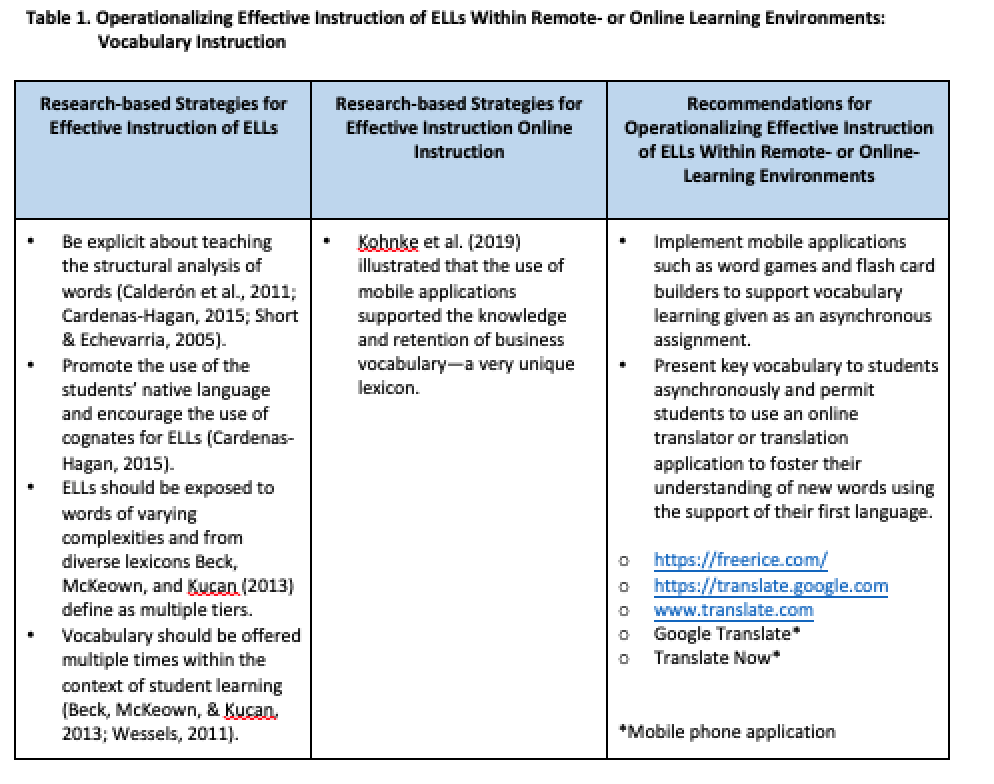References
Batt, E. G. (2008). Teachers’ perceptions of ELL education: Potential solutions to overcome the
greatest challenges. Multicultural Education, 15(3), 39-43. Retrieved from
http://libproxy.usc.edu/login?url=http://search.proquest.com.libproxy2.usc.edu/
docview/216524347?accountid=1474
Beck, I., McKeown, M., & Kucan, L. (2013). Bringing words to life robust vocabulary
instruction (2nd ed.). New York: Guilford Press.
Cadeiro-Kaplan, K., Lavadenz, M., & Armas, E. (2011). Essential elements of effective
practices for english learners. Policy brief. Center for Equity for English Learners,
Loyola Marymount University: Los Angeles, CA.
Calderón, M., Slavin, R., & Sánchez, M. (2011). Effective Instruction for English Learners. The
Future of Children, 21(1), 103-127.
Cardenas-Hagan, E. (2015). Evidence-Based Vocabulary Instruction for English
Learners. Perspectives on Language and Literacy, 41(3), 34–39.
Elfers, A. M., & Stritikus, T. (2014). How school and district leaders support classroom teachers’
work with english language learners. Educational Administration Quarterly, 50(2), 305-
344.
Facella, M.A., Rampino, K. M., & Shea, E. K. (2005). Effective Teaching
Strategies for English Language Learners. Bilingual Research Journal, 29(1), 209-221.
Gersten, R., & Baker, S. (2000). What We Know about Effective Instructional Practices for
English-Language Learners. Exceptional Children, 66(4), 454-470.
Hanson-Smith E. & Rilling S. (Eds.). (2007). Learning languages through technology. Teachers
of English to Speakers of Other Languages, Inc. 700 South Washington Street Suite 200,
Alexandria, VA 22314. Retrieved from
http://ezproxy.canyons.edu:2048/login?url=https://ezproxy.canyons.edu:2457/docview/6
2049731?accountid=382
Harper, C., & de Jong, E. (2004). Misconceptions about Teaching English-Language
Learners. Journal of Adolescent & Adult Literacy, 48(2), 152–162. Retrieved from
http://www.jstor.org/stable/40009164
Haynes, J., Zacarian, Debbie, & Gale Group. (2010). Teaching English language learners across
the content areas (Gale virtual reference library). Alexandria, Va.: ASCD.
Kohnke, L., Zhang, R., & Zou, D. (2019). Using mobile vocabulary learning apps as aids to
knowledge retention: Business vocabulary acquisition. Journal of Asia TEFL, 16(2), 683-
690. Retrieved from
http://ezproxy.canyons.edu:2048/login?url=https://ezproxy.canyons.edu:2457/docview/2
265775254?accountid=38295
Lake, Vickie E., & Pappamihiel, N. E. (2003). Effective Practices and Principles to Support
English Language Learners in the Early Childhood Classroom. Childhood Education,
79(4), 200-03.
Li, N. (2013). Seeking Best Practices and Meeting the Needs of English Language Learners:
Using Second Language Theories and Integrating Technology in Teaching. Journal of
International Education Research, 9(3), 217–222.
Li, S., & Swanson, P. (Eds.). (2014). Engaging Language Learners through Technology
Integration: Theory, Applications, and Outcomes. Hershey, PA: IGI Global. doi:10.4018/978-1-4666-6174-5
Molle, D. (2013). Facilitating professional development for teachers of english language
learners. Teaching and Teacher Education, 29, 197-207. doi:10.1016/j.tate.2012.10.002
Ringler, I., Schubert, C., Deem, J., Flores, J., Friestad-Tate, J., & Lockwood, R. (2015). Improving the asynchronous online learning environment using discussion boards. I-Manager’s Journal of Educational Technology, 12(1), 15-27. Retrieved from http://ezproxy.canyons.edu:2048/login?url=https://ezproxy.canyons.edu:2457/docview/1718069932?accountid=38295
Short, D., & Echevarria, J. (2005, January). Teacher Skills to Support English Language Learners. Educational Leadership, 62(4), 8–13.
Slavin, R. E., & Cheung, A. E. (2005). A Synthesis of Research on Language of Reading
Instruction for English Language Learners. Review of Educational Research, 75(2), 247–
284. Retrieved from http://www.jstor.org/stable/3516050
Ustunel, H. H., & Tokel, S. T. (2017). Distributed scaffolding: Synergy in technology-enhanced learning environments. Technology, Knowledge and Learning, 23(1), 129-160. doi:http://ezproxy.canyons.edu:2069/10.1007/s10758-017-9299-y
Walqui, A. (2006). Scaffolding Instruction for English Language Learners: A Conceptual
Framework. The International Journal of Bilingual Education and Bilingualism, 9(2),
159–180.
Wessels, S. (2011). Vocabulary Learning for English Learners. The Reading Teacher, 65(1), 46–
50.
Wu, W.-C. V., Hsieh, J. S. C., & Yang, J. C. (2017). Creating an Online Learning Community in
a Flipped Classroom to Enhance EFL Learners’ Oral Proficiency. Educational
Technology and Society, 20(2), 142–157.




